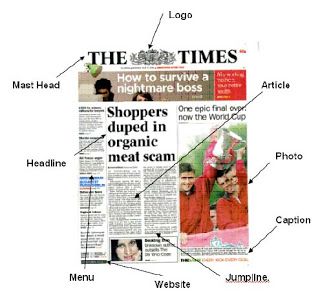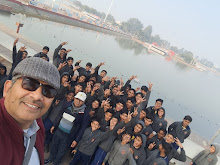CLICK HERE TO WATCH STUDENTS PRESENTATION ON THIS TOPIC
Problem Statement:
Students of classes vi-xii not subscribing to the Discounted and promotional Newspaper Paper scheme of THE TRIBUNE newspaper TIE for even 100 days in a year.
Mission: Create students' interest in reading Newspapers.
Objective: Know all about the Newspaper.
1. What is a Newspaper?
A printed publication (usually issued daily or weekly) consisting of folded unstapled sheets and containing news, articles, advertisements, and Correspondence etc. Etc.
2. History and Types of newspapers available.
History of Newspapers: Watch on U tube Click here
TO KNOW WHEN NEWSPAPER CAME IN TO EXISTANCE AND ITS STAGES OF DEVLOPMENTS TILL DATE.
Newspapers can be classified in different ways depending on
- their format,
- The type of news they cover, and
- their periodicity.
- One classification scheme divides this type of publication into two large groups:
- broadsheets and
- tabloids.
- Initially, this classification was only based on
- the size of the pages.
3. What are its basic, special, and additional features?
A) According to publication format
1. Printed: Is the traditional newspaper. It was born after the invention of printing and was developed along with the evolution of technology associated with paper, photography, graphic design and commerce.
This type of newspaper is also divided according to the dimensions of the paper used for its elaboration:
A) Tabloid : Although currently associated with a newspaper in which sensationalist information is disseminated, the tabloid is a newspaper that usually measures 28 x 35 cm, ie a small format.
B) Standard: Or sheet, is the largest format. It measures approximately 38 x 58 cm. It is common to more traditional newspapers.
2. Digital: Are designed to be displayed in digital format on personal electronic devices. Generally, they are free, although there are those that charge by subscription. Usually, this charge has to do with a greater depth in the information it contains.
3.Mural: Elaborated with collages and clippings of informative and specialized magazines, it is a type of newspaper oriented to the population of school age. It usually inserts itself in the educational center as a punctual project to learn about a specific subject, but also can be found cases in which they become a means of communication within the center.
B) According to their periodicity
- DAILY NP: DISTRIBUTED DAILY
- Weekly NP : They are distributed once a week, normally Saturday or Sunday, and usually contain the news enlarged and complemented with additional details or with the information that is linked to it. They also often give more space to investigative journalism work as well as articles of opinion from renowned personalities in their field.
- Biweekly, monthly or semi-annual newspapers : This periodicity is often distributed institutional or business publications. The type of content that is included in this type of newspaper is usually limited to the interest of a much smaller audience and usually refers to the achievements and projects of the organization in question.
C) According to the time of distribution.
- Morning NP : They are usually of daily circulation and are distributed before dawn so that their readers can"consume"it in the early hours of the morning. They are eminently news.
- Evening NP: It is distributed in the afternoon and may contain information that happened in the morning. In many cases it complements the information published in the morning newspaper.
D) According to its content
- General information : Includes in its pages information on different topics ordered in sections and distributed in the order of priority imposed by the editorial line of the owners of the newspaper.
- Specific content NP that interests a very particular group of people, for example sports newspapers or those of economic subjects.
E) According to the scope of the geographical information it contains
- Local NP: They offer the most fresh and relevant information that concern and interest the inhabitants of a specific locality. Its format, design and distribution points are adapted to the needs and customs of the inhabitants of that geographical space. City or district level
- Community NP : Its scope of action is smaller. It promotes the concept of popular journalism, since it usually includes texts and information written by people who are necessarily journalists. State level.
- National News NP: Includes topics of interest to a complete country and is distributed to the greatest possible extent of that territory. They are larger because they often include sections that reflect the interests of the different sectors that make life in that nation. Country level
- International News papers...
F) According to its cost
- ON Payments NP : Is the most common way of finding newspapers; They pay for them a small sum of money in the different points of sale.
- By subscription NP : It is another payment method in which the reader registers in a distribution list and pays a fee from time to time to receive the publication every time he leaves directly at home, work or email. Source
4. What are the parts and sections of a newspaper?
5. Printing and distribution of newspapers.
The newspaper production process begins with gathering news stories, articles, opinions, advertorials and advertisements to printing and folding of the hard copy. Usually, the news items are printed onto newsprint. The whole production process can be divided into four parts:
- Content gathering,
- Pre-press,
- Press and
- Post-press.
6. Emerging trends and new age newspapers.
Digital Transformation:
Multimedia Integration:
Data Journalism: I
Niche Publications:
Collaborations and Partnerships:
Sustainable Practices:
Digital Transformation: As more readers turn to online platforms for news consumption, print publications have had to adapt. Many newspapers and magazines now offer online editions, allowing readers to access news articles conveniently on their smartphones, tablets, or computers1.
Multimedia Integration: To stay relevant in the digital age, print journalism increasingly incorporates multimedia elements into its storytelling. This includes videos, infographics, podcasts, and interactive features, enhancing the reader’s experience and bridging the gap between traditional print and digital media.
Data Journalism: In an era of big data, print journalism has embraced data-driven reporting. By analyzing and visualizing large datasets, journalists uncover insights and trends, providing readers with a deeper understanding of complex issues.
Niche Publications: While the traditional newspaper model may be declining, there’s still a demand for niche publications. These cater to specific interests and communities, focusing on specialized topics like fashion, lifestyle, or industry-specific news.
Collaborations and Partnerships: Print journalism has embraced collaborations with other media outlets and organizations. Content-sharing agreements, joint investigative projects, and cross-promotions help reach wider audiences and ensure continued relevance.
Sustainable Practices: Environmental concerns are increasingly important. Print journalism is adopting sustainable practices to minimize its impact.
.................................................................
Methodology:
- Class XI will
- Collect one old newspaper each from the library and
- Read literature on the topic from "Abhivyakti aur Madhyam' NCERT TEXTBOOK XI-XII with help of their language teachers.
- Search project related information from the Internet in a group of 5-6 students.
- Select the required information on all the above 6 points, appended.
- Organize this information.
- Information is color coded and allotted almost equally to all the students chronically/ roll no wise ON WHATSAPP.
- Design or create placards to display or exhibit on above.
- Inverted pyramid is one essential.
- A narrator will script the event write-up with the help of their language teachers.
- Practice in Library and present it on Saturday during morning assembly.
- Each student will speak FEW lines about newspaper, holding one NP in his hand, roll number wise from this article starting from the top roll no 1.
- Class may take help of students who are not speaking on dais.
- All the best
- Your only Chance to win /lose an exciting career counselor free for a lifetime.
- Outcome :
- Increased readership of newspapers among the students.
- Increased GK & Current awareness of students.
- Be able to create their own Reports, Newspaper, News, Advertisements, Editorials etc. & score good marks in language subjects through practical knowledge.
- Be a lifelong newspaper reader.




.jpeg)
.jpeg)

.jpeg)
.jpeg)
.jpeg)
.jpeg)

.jpeg)
.jpeg)

.jpeg)

.jpeg)

.jpeg)





.jpeg)
.jpeg)

.jpeg)
.webp)



.webp)

.jpeg)
.jpeg)
.webp)

.jpeg)

.jpeg)
.jpeg)
.jpeg)


